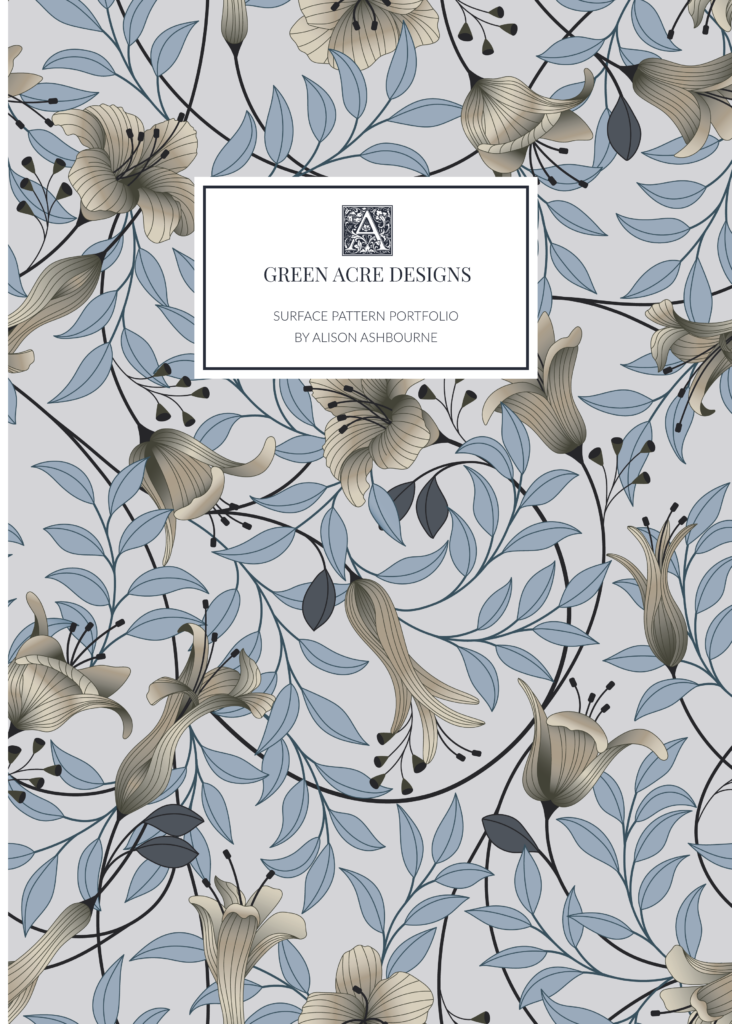Designing My Portfolio
July 29, 2023
I did it!
I created my first portfolio! And I actually enjoyed the process.

Click on my portfolio to have a look inside!
But I knew from the beginning that it’s hard to begin when you don’t know where you’re heading.
So my first step was to have some sort of an idea of what I wanted to create. I started searching for other surface designers’ portfolios online so I could have some idea of what I was going to do. And Issuu was the most wonderful resource! Why hadn’t I thought of that before? There were a lot of portfolios I could flick through so I had a good browse and was able to learn a lot. After several hours of sticky beaking, I had come up with a basic list of what I liked and what I didn’t. I found I liked the portfolios where each page was presented as a piece of art itself. I favoured the portfolios where the patterns were presented more randomly on the page. I determined pretty quickly that the page templates I had just purchased would not give me the layout I wanted to use for the whole portfolio. They were too rigid and neat. They didn’t allow me to tell a story. Even though I wasn’t going to use the templates for each page they did provide me with learning how a book could be designed in Illustrator. I hadn’t even thought about it but each artboard was a separate page! And that turned out to be a big time saver.
So I now had an idea of what I wanted to include in my portfolio. I had come up with a list of ideas for the layout and overall presentation. I had the purchased template to help me create my portfolio in Adobe Illustrator. I had the ability to create mockups. And I had 3 pattern collections plus a bunch of individual patterns that were ready to be featured. But I was missing one important thing. The one thing I wish I’d done before embarking on my portfolio was having some brand photos taken. I’ve never enjoyed having my photo taken. The reality is that I’ve only got a handful of photos of myself from the last 20 years. I’d very much rather take the photos than pose. My darling daughter took a few of me when I was designing my website a few months back so they were my only resource. They would have to do. I kept remembering what I’d been learning about the importance of moving forward – it doesn’t need to be perfect, it just needs to be done! I could always create another portfolio any time I wanted. The important thing was to just do it!
It took about a week of solid work but by the time it was finished I had realised how much art I had created since starting this journey. And, more surprisingly, the work was actually . . . . okay. I’d been told that creating a portfolio really ties things together and allows you to reflect. And they were right. The moment it was finished I felt like I’d really achieved something. I realised how much I had learned to get this far.

The next step was to get it ready to share. After a lot of trial and error and combining PDF’s (something new to me) I am proud to say I published my portfolio on Issuu. The actual process was quite easy and I loved how it automatically created a post of my portfolio on my Instagram account. That was a surprise. Talk about getting it out there immediately.
The next thing I did was to get some hard copies printed. Every tutorial, blog, instructional video I’d come across about surface design portfolios suggested it was a good idea to have hard copies ready should an art director prefer that format. So after a lot of research (taking in to consideration my tech limitations and the reality of being in Australia) I ordered my books. It was a big expense. And I don’t know if I would order 20 copies again. To date, no one has requested a hard copy, but it made it all feel real when they arrived. I opened the box and marveled at the pages. The colours were just as I wanted. The page layouts worked. It was a quality book. I made it. I designed it. And it was a true reflection of me. That was special. I felt very proud!
Then I was left with the reality that I actually needed to send it out to real people if I had any chance of becoming a licensed artist. Pitching. Even though I was apprehensive I just had to remind myself that I was proud of my portfolio.
What do I include in an email? How do I promote myself when I’m definitely not in to marketing at all? How many other designers are doing what I’m doing? Is there really room for me? How do I find an art director’s name? How do I keep track of the companies I reach out to? Will anyone actually respond?
Now I’m in the middle of learning all about the next stage – pitching!
So if you are reading this post and are about to create your own portfolio I hope my story has helped you pluck up the courage to get stuck in and do it! Just like me, you might end up learning a whole new set of skills and enjoying the whole process!
